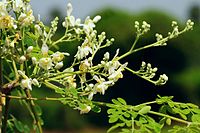
Photo from wikipedia
Simple Summary The study examined whether dietary supplements such as citrate or NaCl have an influence on the development of urinary calcium oxalate crystals in fattening pigs. There were three… Click to show full abstract
Simple Summary The study examined whether dietary supplements such as citrate or NaCl have an influence on the development of urinary calcium oxalate crystals in fattening pigs. There were three examination groups: a control group, a citrate group and a NaCl group. Parameters of comparison were performance (average daily gain and feed intake, feed conversion ratio, water consumption), blood parameters (bone resorption and bone formation markers, calcium, phosphorus, potassium and parathyroid hormone), macroscopic (stones, grit) and microscopic (crystals) examination of the urine and biochemical urinalysis of samples taken at the farm and at the slaughterhouse. There were no beneficial effects of feed supplementation with citrate or NaCl on the development of crystals in the urine of fattening pigs. On the contrary, citrate has a clear promoting influence on the development of alkaline calcite crystals. Substantial differences are found between microscopic and biochemical urinalysis results from samples taken at the farm and at the slaughterhouse. Slaughterhouse samples do not fully reflect the situation on the farm. Abstract The present study investigated whether dietary supplementation of tripotassium citrate or NaCl reduced the prevalence of calcium oxalate dihydrate (COD) uroliths in fattening pigs on a farm with a high prevalence of COD uroliths. Each group (control, TPC, NaCl) consisted of three batches of approximately 260 fattening pigs each. Performance, water intake, markers for bone resorption (CTX) and bone formation (osteocalcin) and urinalysis from samples taken at the farm and in the slaughterhouse were investigated. Performance parameters, feed and water intake, CTX and osteocalcin were not significantly different between the groups (p > 0.05). The main crystals found were struvite, COD, calcite and amorphous crystals. The prevalence of COD crystals was lower in samples from the slaughterhouse in each group. Microscopic and biochemical examination of urine showed large differences between samples from the farm and the slaughterhouse. In conclusion, there were no beneficial effects of feed supplementation with TPC or NaCl on the prevalence of COD crystals but TPC has a clear promoting influence on the development of alkaline calcite crystals. Urinalysis from samples taken at the slaughterhouse does not fully reflect the situation on the farm.
Journal Title: Veterinary Sciences
Year Published: 2022
Link to full text (if available)
Share on Social Media: Sign Up to like & get
recommendations!